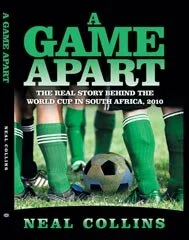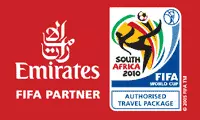THE World Cup venues in South Africa are so diverse, they could just be the key to England’s success next summer. Before tomorrow’s draw in Cape Town, players, WAGS and fans might be interested in a quick guide to the nine towns on offer.
From Cape Town in the south to Polokwane in the north, the grounds for next year’s tournament are stretched over 1,000 miles, the equivalent of travelling the length of England - and back.
The climate ranges from tropical to Mediterranean, the altitude from sea level in Cape Town, Durban and Port Elizabeth to a breathless 5,000 feet in Johannesburg, with Pretoria, Rustenburg, Nelspruit. Bloemfontein and Polokwane also high on the escarpment which rises in the centre of the country.
Next June will be winter in South Africa, but that doesn’t guarantee rain. The inland cities (Johannesburg, Pretoria, Bloemfontein, Nelspruit, Polokwane and Rustenburg) are basically parched from April to September, with rainfall in the summer only. Though the World Cup pitches will be watered, generally amateur football is played on concrete-like surfaces with dead grass in the winter. Overnight frosts are not uncommon.
On the coast, Cape Town has winter rain, much like Britain, while steamy Durban can be wet all year round – though it has also suffered years of drought in the past. Port Elizabeth lies somewhere between the two, geographically and climatically.
Then there’s the development to consider. Cape Town is essentially a European city plonked on the end of the continent, with a rich history and nearby wine lands. Port Elizabeth and Durban are pleasant seaside resorts, though tropical Durban can get extremely humid in the summer, our winter.
Downtown Johannesburg has improved but Sandton, to the north, is where the cricket and rugby teams generally reside and offers just about everything a British town could offer. Similarly, the middle of Pretoria is not as welcoming as you’d hope, but Centurion to the south is stockbroker belt as far as shops and restaurants go.
England won’t want to go to the outlying areas though. Polokwane is remote and too far north to be a tourist trap, though it is surrounded by game parks. Nelspruit offers great hiking trails and forests but is by no means a metropolis. And Rustenburg, though close to the casinos and golf courses of Sun City, is hardly where you’d want to spend a holiday.
And then there’s Bloemfontein. It’s a big city but no paradise for English tourists. Though Bloemfontein Celtic, the local professional side, offer perhaps the most demonstrative fans in the South African Premier Division, Bloemfontein is generally considered, like Pretoria, a bastion of rugby and Afrikanerdom. Though things are changing since the outbreak of democracy in 1993, English accents are not always greeted with welcoming smiles.
Fabio Capello, though tempted to ban the wives and girlfriends, knows the WAGS will come out for the World Cup. But if the side are drawn to play in Nelspruit, Rustenburg, Bloemfontein or Polokwane, God help them. Let’s get this straight, these are not holiday resorts, they are remote African towns unsuitable for wandering the shops and going out at night. During the World Cup, there will be a livelier atmosphere, but visit those town centres tomorrow and you’d find it pretty inhospitable. It’s hard to imagine 20,000 England fans happily spending a few days in any of them.
Though plush game reserves surround the three northern cities there are no obvious places for WAGs or fans to amuse themselves. Bloemfontein offers more but a London orbital town like Watford would be far more vibrant. Though the FA has looked at Rustenburg’s soccer academy as a possible pre-tournament camp venue, those four cities are not quite what England will be after.
Johannesburg and Pretoria, though also at altitude, which presents its own problems, can offer reasonable facilities for fans and WAGs... as long as they do as they’re told. There are areas around both cities which will suit English travellers and Loftus Versveld, the World Cup ground in Pretoria, is a reasonable venue for fans to prepare for a match.
Ellis Park in central Johannesburg and Soccer City, near Soweto, are less welcoming but should be well marshalled during matches. Again, fans would be advised not to wander too far afield at either venue.
But if it’s a quality World Cup England and their fans are after, the coastal cities should provide it.
Durban’s brand new Moses Mobhida Stadium (pictured) is a monumental effort, complete with a Wembley-style arch and a walkway to the nearby North Beach, which is really what the biggest city in KwaZulu Natal is all about. Though the centre of Durban shows signs of decay, new developments around the once-feared harbour end of town have improved matters. North of Durban, England fans might find plush beach resorts like Umhlanga and Ballito worth exploring. Durban also offers some of the largest shopping malls in the country, with Gateway near Umhlanga the largest in the southern hemisphere. It’s WAG paradise with every designer outlet and for fans, there are rooftop go-karts, 10-pin bowling, cinemas, a theatre and plenty of restaurants.
Port Elizabeth is smaller than Durban and again, the centre shows signs of decay. But south of the city offers similar beachside facilities to Durban, with casinos and safe night-time venues. Not renowned as a football hub, Bayi, as it is now known, boasts the country’s loudest cricket fans and a good match-day atmosphere. Hopefully they’ll turn up for the football too.
And finally, saving the best to last, we travel down the beautiful Garden Route from Port Elizabeth to Cape Town and the new Green Point Stadium. The oldest city in South Africa has it all. The cable car up Table Mountain, the cruise out to Robben Island, the Victoria and Albert Waterfront, the nearby winelands. Paradise. England’s cricket and rugby fans will confirm that Cape Town is the place to be for players, fans and hangers-on. There are dozens of top-of-the-range shopping malls and, unlike the rest of South Africa, the houses are not fenced in. Cape Town has a less paranoid approach to crime.
In summary:
Where England want to be:
• Green Point Stadium, Cape Town (70,000)
Perfect draw for England. No altitude to worry about, winter’s much like England but slightly warmer. Fine new stadium.
• Moses Mobhida Stadium, Durban (68,000)
Winter will ease the tropical problems of heat and humidity, great beaches even in winter...and another brand new stadium.
• Nelson Mandela Stadium, Port Elizabeth (50,000)
Stay south of the city for the best of Bayi, plenty of English settler history inland, beautiful coastline north and south
Where England will struggle with altitude but might be okay:
• Ellis Park Stadium, Johannesburg (60,000)
Situated close to the centre of the golden city, it still feels a bit intimidating in the streets but a ground with a big history.
• Soccer City, Johannesburg (95,000)
Close to Soweto, great stadium with an African design, but needs further development around the ground
• Loftus Versfeld Stadium, Pretoria (45,000)
Home of the rugby gods the Blue Bulls, pleasant area near centre of Pretoria, shouldn’t be a problem
Where England won’t want to be:
• Mbombela Stadium, Nelspruit (40,000)
It’s a small town, good for game reserves and hiking but not football fans. Trouble over the new stadium appears to be over.
• Free State Stadium, Bloemfontein (40,000)
It’s not a town you instantly fall in love with but it’s big and bustling and the stadium is an established rugby venue
• Royal Bafokeng Stadium, Rustenburg (40,000)
Sun City, half-an-hour away, is worth a visit. Rustenburg isn’t, though it has been pushed as a big footballing venue of late
• Peter Mokaba Stadium, Polokwane (40,000)
Once known as Pietersburg, Polokwane is a remote northern town, a long way from the centre of the action
Labels: bloemfontein, cape town, durban, grounds, guide, johannesburg, nelspruit, polokwane, port elizabeth, pretoria, rustenburg, World Cup venues








